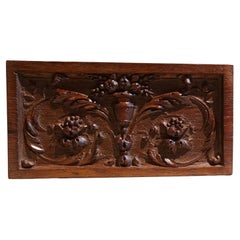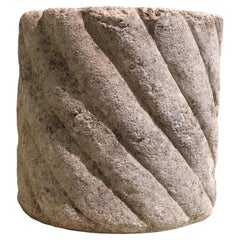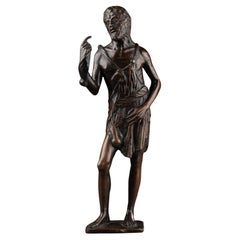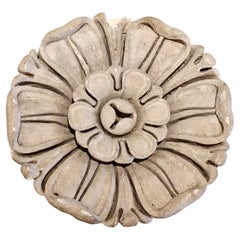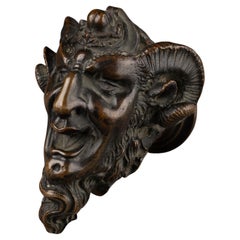Furniture
to
35
110
109
1
8
8
2
1
1
1
1
1
1
88
14
7
1
2
4
1
3
1
41
29
24
20
15
100
68
15
8
5
110
110
110
1
1
1
Decorative Carved Panel - France, 19th Century
Located in Bruxelles, BE
Decorative Carved Panel
France, 19th Century
15,5 x L 30,5 x 3 cm
Carved in richly grained wood, this 19th-century decorative panel draws direct inspiration from Renaissance ornamen...
Category
Antique Early 19th Century French Renaissance Wall-mounted Sculptures
Materials
Wood
17th century twisted column
Located in Bruxelles, BE
Twisted Column
Italy, 17th Century
H 22 cm x diameter 21,5 cm
central hole diameter : 9,2 cm
This sculpted stone, dating from the 17th century, is a fragment of a twisted or helical...
Category
Antique 17th Century Italian Renaissance Planters and Jardinieres
Materials
Stone
Saint John the Baptist
- After a model by Bertoldo di Giovanni
Located in Bruxelles, BE
Saint John the Baptist
Bronze
After a model by Bertoldo di Giovanni (ca. 1440–1491)
Northern Italy, 18th century
27,5 x 8 x 5 cm
This finely cast and patinated bronze statuette ...
Category
Antique Late 18th Century Italian Renaissance Figurative Sculptures
Materials
Bronze
Large carved stone rosette - France, 18th century
Located in Bruxelles, BE
Large carved stone rosette
France, 18th century
Diameter: 29.5 cm
This carved rosette likely adorned a ceiling. This rounded vault key exhibits a delicately crafted decor, with deep...
Category
Antique Mid-18th Century French Other Garden Ornaments
Materials
Stone
$2,598 / item
Handle in the Shape of a Devil’s Head - France, 19th century
Located in Bruxelles, BE
Handle in the Shape of a Devil’s Head
Patinated bronze
France, 19th century
10 x 7,5 x 9 cm
This unusual bronze handle takes the expressive form of a devil’s head, with exaggerate...
Category
Antique Early 19th Century French Other Figurative Sculptures
Materials
Bronze
Study of a Satyr - Italy, early 19th century
Located in Bruxelles, BE
Study of a Satyr
Bronze, cast using the lost-wax (cire perdue) method
Italy, early 19th century
14 x 7 x 10 cm
This evocative bronze sculpture represents a satyr, the half-human, h...
Category
Antique Early 19th Century Italian Modern Figurative Sculptures
Materials
Bronze
Renaissance Harpy - Italy, 16th century
Located in Bruxelles, BE
Renaissance Harpy
bronze
Italy, 16th century
15 x 12 x 5,5 cm
This expressive bronze figure represents a harpy, a mythological creature with the body of a bird and the head and tor...
Category
Antique 16th Century Italian Renaissance Figurative Sculptures
Materials
Bronze
Bronze crabe - Padua, 18th century
Located in Bruxelles, BE
Bronze crabe
Padua, 18th century
bronze
2 x 10 x 7 cm
(One of the crab’s legs is missing its end)
This finely cast bronze sculpture of a crab reflects the enduring interest in natur...
Category
Antique Mid-18th Century Italian Renaissance Revival Animal Sculptures
Materials
Bronze
Bronze salamander - 17th century
Located in Bruxelles, BE
Bronze salamander
Italy, 17th century
Patinated bronze
4 x 17 x 10 cm
This finely cast bronze salamander exemplifies the 17th-century fascination with naturalistic forms and animal ...
Category
Antique 17th Century Italian Renaissance Animal Sculptures
Materials
Bronze
Large Imperial Black Porphyry specimen
Located in Bruxelles, BE
Rare and Large Imperial Black Porphyry architectural fragment
partially polished,
23,5 x 15 x 12 cm
Porfido Nero is a rare Black Variety of Imperial Porphyry from Gebel Dokhan (th...
Category
Antique 15th Century and Earlier Italian Classical Roman Natural Specimens
Materials
Porphyry
Two bases in rare Breccia Africano and Granito Nero
Located in Bruxelles, BE
Two bases in rare Breccia Africano and Granito Nero
Cylinder in Breccia Africano
H 12.5 × D 7 cm
Cylinder in Granito Nero
H 6 × D 9 cm
These two cylindrical bases made of rare marb...
Category
Antique Early 19th Century Italian Neoclassical Natural Specimens
Materials
Marble
Elegant base in porfido Serpentino Antico
Located in Bruxelles, BE
Elegant fragment in porfido Serpentino Antico
19,5 x 18 x 12 cm
This beautiful fragment can be used as a base made of rare marble, ideal for displaying ancient or modern objects and...
Category
Antique 15th Century and Earlier Italian Classical Roman Natural Specimens
Materials
Marble
AFTER A MODEL BY GIAMBOLOGNA (1529–1608) - Pacing Bull
Located in Bruxelles, BE
AFTER A MODEL BY GIAMBOLOGNA (1529–1608)
Pacing Bull
17th century
Bronze, on an ebonised wood base
H totale 15 x L 11,5 x P 8,2 cm
Since antiquity, the bull has been venerated as ...
Category
Antique 17th Century Italian Renaissance Animal Sculptures
Materials
Bronze
reclining lion in finely chased bronze - Italy, 15th century
Located in Bruxelles, BE
Small reclining lion in finely chased bronze
Italy, 15th century
Traces of gilding
H 4,8 x L 6 x P 2 cm
Delicately worked bronze depicting a lion in repose, characteristic of early ...
Category
Antique 15th Century and Earlier Italian Gothic Animal Sculptures
Materials
Bronze
Pacing Horse - Italian School, 18th century
Located in Bruxelles, BE
Italian School, 18th century
Pacing Horse
Bronze with brown patina, on a rectangular marble base
H 8 x L 8,5 x P 3 cm
H totale 11 cm
Category
Antique 18th Century Italian Baroque Animal Sculptures
Materials
Marble, Bronze
Corbel with an Angel Holding a Shield
- Burgundian Netherlands 15th century
Located in Bruxelles, BE
Corbel with an Angel Holding a Shield
Franco-Flemish, Burgundian Netherlands 15th century
Limestone
On a modern metal stand
H 21 x L 16,5 x P 18,5 cm
This finely carved stone corbel,...
Category
Antique 15th Century and Earlier Belgian Gothic Figurative Sculptures
Materials
Limestone
Circle of Pierpaolo and Jacobello Dalle Masegne (Venice, late 14th century)
Located in Bruxelles, BE
Circle of Pierpaolo and Jacobello Dalle Masegne (Venice, late 14th century)
San Bartolomeo
high relief 'en applique'
white marble
52 x 30 x 14 cm
Provenance :
Collection South of...
Category
Antique 15th Century and Earlier Italian Gothic Figurative Sculptures
Materials
Marble
Renaissance Winged Cherub Relief
- Florence, 15th century
Located in Bruxelles, BE
Renaissance Winged Cherub Relief
Florence, Second Half of the 15th Century
Stone with traces of polychromy
Provenance: Important private collection, Northern Italy
This exceptional...
Category
Antique 15th Century and Earlier Italian Renaissance Figurative Sculptures
Materials
Stone
Bacchus - Southern Italy, late 17th century
Located in Bruxelles, BE
Bacchus
Southern Italy, late 17th century
Alabaster Sculpture
H: 20 cm
A finely carved 17th-century alabaster sculpture of a naked Bacchus. This Italian alabaster figure depicts ...
Category
Antique 17th Century Italian Baroque Figurative Sculptures
Materials
Alabaster
Dutch Tobacco Jar - 19th century
Located in Bruxelles, BE
Dutch Tobacco Jar
Hollande, 19th century
H 18 x diameter 12 cm
Fine Georgian Dutch Tobacco Jar with beautiful patina.
Category
Antique 19th Century Dutch Georgian Snuff Boxes and Tobacco Boxes
Materials
Wood
Dutch Tobacco Jar - 19th century
Located in Bruxelles, BE
Dutch Tobacco Jar
Netherlands, 19th century
23 x 15 cm
Georgian Dutch Tobacco Jar. Made from different woods, this ring turned Jars show a very nice patina.
Category
Antique 19th Century Dutch Georgian Snuff Boxes and Tobacco Boxes
Materials
Fruitwood
Allegory of Africa - 16th century
Located in Bruxelles, BE
Flemish school of the 16th century
Allegory of Africa
After The Allegories of the Continents by Maerten de Vos (engraving by Adriaen Collaert)
Oil on copper
Inscription: "Giulio Ro...
Category
Antique 16th Century Belgian Renaissance Paintings
Materials
Copper
The Martyrdom of Santa Barbara - Bruges, 1530-50
Located in Bruxelles, BE
The Martyrdom of Santa Barbara
Wool and silk tapestry
Bruges, 1530-50
270 x 198 cm
Expertise by Professor Guy Delmarcel
This Flemish tapestry is a remarkable example of 16th-century craftsmanship, distinguished by its exceptionally well-preserved color palette.
The medaillon-shaped center stands out against a background of dark blue roses and acanthus leaves. It depicts the martyrdom of Saint Barbara, identified by the tower where she was imprisoned. According to legend, her father, Dioscorus, is about to behead her with a scimitar, while an angel descends from the heavens to strike him with lightning.
At the bottom, beneath Saint Barbara, two fantastical creatures. On the left is a griffon depicted with the body of a lion and the head and wings of an eagle. On the right is a creature with the body of a leopard, the head of an elephant adorned in a fancy blue cloak. Both animals face each other standing either side of a green hill top in the middle of the tapestry.
The lavish scene of the tapestry is framed by a border which is embellished with foliage, flowers and fantastical elephant heads in blue and white on a red background. The corners and center of the edges display goldsmith-objects. The vibrant brick-red colour and striking bluish-green leaves create a stunning visual impact, showcasing the outstanding state of conservation.
Professor Guy Delmarcel connects this tapestry to a series of textiles produced in Bruges after 1530, characterized by their fantastical nature scenes populated with imaginative creatures. Most feature similar roses and acanthus-leaves as well as other vegetation, with wild animals appearing ready to attack. Two almost identical pieces preserved at the Art Institute of Chicago (Bruges, 336 x 599 cm) and the Rijksmuseum in Amsterdam ("Tournai," 285 x 490 cm) serve as prime examples. The entire surface is filled with greenery, along with birds and fantastic animals.
This tapestry exemplifies the rich decorative style of the time, merging naturalistic and poetic elements with exotic animals that spark the imagination.
Other works of this type follow the theme of the "Closed Garden." In the lower register, fantastical creatures occasionally appear, as seen in the exquisite Bruges Tapestry displayed at the Museum of Decorative Arts in Paris, and in the example from the Burrell Collection in Glasgow. The Parisian tapestry from Bruges features a mythical animal in the lower register, dressed in blue fabric, which closely resembles the animal in our tapestry.
If Enghien or other centers produced similar pieces, several elements suggest a stronger connection to Bruges for two formal reasons:
The overall colour-palette of our tapestry fabric characterized by pronounced brick-red colours and bluish-green leaves, aligns more closely with Bruges than with Tournai or Enghien.
The intricate border design with the warm brick-red background, adorned with floral motifs, goldsmith-inspired elements such as incense burners and small bells, can be traced back to Bruges around 1530. This style, often associated with heraldic imagery, underscores the tapestry's connection to the city's rich artistic heritage. A comparable example is the tapestry featuring the Arms of Paolo Giovio, now part of the Prince of Liechtenstein's collection in Vaduz. This piece, set against a brick-red background, depicts arms and armors, cornucopias, boys riding grotesque dolphins, as well as various flowers and leaves.
All available literature dates this group of tapestries to the second quarter of the sixteenth century. A key formal element further supports this dating: the executioner, depicted preparing to behead Barbara, wields a Turkish scimitar, a reference to the frequent Ottoman incursions into Central Europe beginning with the 1529 siege of Vienna...
Category
Antique 16th Century Belgian Renaissance Tapestries
Materials
Wool, Silk
Followers of Jean de la Huerta, Jean de Blany ? - Saint Jerome
Located in Bruxelles, BE
Followers of Jean de la Huerta, Jean de Blany ?
Saint Jerome
Limestone
Burgundy, second half of the15th century
60,5 cm
ALR Ref : S00248050
This exquisite sculpture of Saint Jerome, carved from soft, nearly white limestone typical of eastern France, exemplifies the exceptional craftsmanship of 15th-century Burgundian art. The figure of Saint Jerome, a key figure in Christian history renowned for translating the Bible into Latin, is depicted wearing a cardinal’s hat and holding the Vulgate Bible...
Category
Antique 15th Century and Earlier French Renaissance Figurative Sculptures
Materials
Limestone
Veneto- Saracenic candlestick - 15th century
Located in Bruxelles, BE
Veneto- Saracenic candlestick
Engraved bronze
15th century
13 x 8,5 cm
This rare candlestick exemplify exquisite craftsmanship, featuring a bell-shaped base with a flared foot adorn...
Category
Antique 15th Century and Earlier Italian Renaissance Chandeliers and Pen...
Materials
Bronze
Veneto- Saracenic candlestick - 15th century
Located in Bruxelles, BE
Veneto- Saracenic candlestick
Engraved bronze
15th century
12,5 x 6,2 cm
This rare candlestick exemplify exquisite craftsmanship, featuring a bell-shaped base with a flared foot ado...
Category
Antique 15th Century and Earlier Italian Renaissance Chandeliers and Pen...
Materials
Bronze
Renaissance grotesque in the shape of a half-moon - France, 17th century
Located in Bruxelles, BE
Large grotesque in the shape of a half-moon
On a posterior cement base
Limestone
France, 17th century
72 x 42 x 51 cm
Category
Antique 17th Century French Renaissance Statues
Materials
Limestone
Egyptian Fragment of a Seated Man - Ancient Egypt, 26th Dynasty (664-525 BC)
Located in Bruxelles, BE
Egyptian Fragment of a Seated Man
Limestone - polychromy
Ancient Egypt, 26th Dynasty (664-525 BC)
Most likely from the tomb of Montw-m-H3t
Provenanc...
Category
Antique 15th Century and Earlier Egyptian Egyptian Figurative Sculptures
Materials
Limestone
Roman Lion's Protome - Gallo-Roman, 2nd century AD/3rd century
Located in Bruxelles, BE
Roman Lion's Protome
Sandstone
Gallo-Roman, 2nd century AD - 3rd century
Provenance : Private Collection Prof. Giesen (Konstanz on Bodensee), pré 1945
Most likely from the Chateau a...
Category
Antique 15th Century and Earlier German Classical Roman Animal Sculptures
Materials
Sandstone
Canaanite Anthropoid Coffin Lid - 12th-10th century BC
Located in Bruxelles, BE
Rare Canaanite Anthropoid Coffin Lid
Terra Cotta
12th – 10th Century BC
Provenance:
Public Auction Paris (2022)
Private Collection F. Antonovich (Paris – 1980s)
Art Loss Register...
Category
Antique 15th Century and Earlier Israeli Archaistic Wall-mounted Sculptures
Materials
Terracotta
Two rare Figures in Turkish Attire - Venice, early 17th century
Located in Bruxelles, BE
Rare Bronzes Depicting two Figures in Turkish Attire
Possibly Suleiman the Magnificent at two different ages
bronzes, alabaster bases
Venice, early 17th century
19,5 x 6 x 5 cm
These two rare bronze statuettes represent two figures dressed in elaborate "Turkish" attire. They are mounted on alabaster bases with bronze reliefs—one featuring the winged lion of Venice, and the other possibly symbolizing Turkey with a wolf depiction.
One figure wears a grand külah, a spherical turban with a cone top, signifying royal authority, while the other has a wrapped turban, denoting rank and religious identity. Their garments are richly detailed with intricate engravings, suggesting luxurious fabrics of the Ottoman court.
The statuettes may represent Suleiman the Magnificent at two different stages of life, as both young and old. The sultan depicted alongside the winged lion corresponds to a description from a Venetian delegate in 1534, when Suleiman was 43. At that time, he had conquered Iraq from the Safavids and achieved a decisive victory over the Papal fleet at the Battle of Preveza. He was described as having large eyes, an aquiline nose, and long red mustaches—traits visible in Cristofano dell'Altissimo’s portrait of Suleiman in the Uffizi Gallery in Florence.
Unlike Mehmed II, who commissioned portraits by European artists for diplomatic purposes, Suleiman did not directly order such representations. Instead, his likeness spread through works by artists like Albrecht Dürer, based on sketches made by diplomats. Following his capture of Belgrade in 1521, his victory over Hungary in 1526, and his siege of Vienna...
Category
Antique 17th Century Italian Renaissance Figurative Sculptures
Materials
Alabaster, Bronze
Circle of Pietro Cavallini - St. Bartholomew - 14th century Fresco
Located in Bruxelles, BE
Circle of Pietro Cavallini (Rome, 1250–1330)
St. Bartholomew
Fresco transferred onto canvas
Umbria, 14th century
66.5 x 40 cm
Provenance:
Collection of Raymond Van Marle (The Hagu...
Category
Antique 15th Century and Earlier Italian Medieval Paintings
Materials
Canvas, Plaster
Head of a crowned Virgin - Lorraine, first half of 14th century
Located in Bruxelles, BE
Head of a crowned Virgin
Lorraine, first half of 14th century.
H26 x 14 x 14 cm
Provenance :
- Private Collection, Paris France (1960)
Private Collection Tuscany, Italy (1980)
Ex...
Category
Antique 15th Century and Earlier French Gothic Figurative Sculptures
Materials
Limestone
Bolognese School of the 16th Century - Mummy of Saint Catherine of Bologna
Located in Bruxelles, BE
Bolognese School of the 16th Century
Mummy of Saint Catherine of Bologna
Oil on Panel
20,5 x 7 x 0,8 cm
This rare painting depicts Saint Catherine of Bologna as a mummy, housed in a ...
Category
Antique 16th Century Italian Renaissance Paintings
Materials
Wood, Giltwood
$3,306 Sale Price
20% Off
double capital - french, end of 13th century
Located in Bruxelles, BE
Double capital with hook decorations
Grey stone
France, 13th century
Reduced—cut in the back in modern times
H 22 x L 41 x P 20 cm
'Hook' is the name given today to these ornamen...
Category
Antique 15th Century and Earlier French Medieval Architectural Elements
Materials
Stone
Coptic textile Byzantine Period; 4th–5th Century C.E.
Located in Bruxelles, BE
Coptic textile
Byzantine Period; 4th–5th Century C.E.
Materials: linen, Wool
23 x 16 cm
This fragment features black decorations on a beige background, depicting human figures with...
Category
Antique 15th Century and Earlier Egyptian Egyptian Antiquities
Materials
Wool, Linen
Kapati textile - Epoque Byzantine; 4th–5th Century C.E
Located in Bruxelles, BE
Kapati Textile
Byzantine Period; 4th–5th Century C.E.
Materials: Plant and Animal Fibers, Wool
9,5 x 9,5 cm
This woolen fabric is woven in the traditional Coptic Kapati style, characteristic of Egypt during the Christian era. The name "Kapati" refers to the Copts of Egypt and describes a weaving technique that does not use embroidery or printing. It is said that Al-Muqawqis, the governor of Egypt, offered the Prophet garments made from Kapati fabric.
At the 1900 Exposition Universelle in Paris, the French archaeologist Albert Gayet showcased the results of his excavations from the winter of 1898-1899. Around one hundred Coptic textiles and fragments were displayed at the Palais du Costume. Their aesthetic generated considerable enthusiasm, particularly among artists like Auguste Rodin and Henri Matisse. This led to a "Coptomania," which, among other things, influenced fashion designers.
The square fragment features black decoration on a beige background; the two squares at the center are separated by scalloped edges, from which hang various ornaments or geometric motifs. At the center of the fragment is an image of a dancing figure surrounded by geometric decorations. This piece dates back to a time when ancient...
Category
Antique 15th Century and Earlier Egyptian Egyptian Antiquities
Materials
Wool, Natural Fiber
French topographic embossed map in three dimensions of ancient Jerusalem - 19th
Located in Bruxelles, BE
French topographic embossed map in three dimensions of Ancient Jerusalem
19th century
wood and hand-coloured plaster
10,5 x 43 x 58 cm
Provenance : Private collection UK
Wood and ...
Category
Antique 19th Century French Belle Époque Models and Miniatures
Materials
Plaster, Wood
Wool Tapestry from Egypt
- 5th–7th Century C.E.
Located in Bruxelles, BE
Wool Tapestry from Egypt
Late Antique Period; 5th–7th Century C.E.
This band fragment features geometric decorations in red and black.
Textiles like this are believed to have been...
Category
Antique 15th Century and Earlier Egyptian Egyptian Tapestries
Materials
Wool
Christ - Umbria, second half of the 15th century
Located in Bruxelles, BE
Christ
Umbria, Orvieto?
Second half of the 15th century
77 x 16.5 cm
Category
Antique 15th Century and Earlier Italian Renaissance Figurative Sculptures
Materials
Walnut
Vittorio Amadio - two African Masks, 2004
Located in Bruxelles, BE
Vittorio Amadio (Italy, 1934)
African Masks
Acrylic on canvas
Signed on the back, 2004
30 x 40 cm
Authenticity certificate
Vittorio Amadio experiments with non-form as an essenti...
Category
Early 2000s Italian Modern Paintings
Materials
Canvas, Acrylic
$1,151 Sale Price
35% Off
17th century apothecary's ivory mortar - Indo-Portuguese
Located in Bruxelles, BE
17th century apothecary's ivory mortar
Apothecary's ivory mortar 9
Indo-Portuguese
17th century
Cites certificate number IT/CE/2023/MI/01108
11 x 9,5 cm
Category
Antique 17th Century Indian Renaissance Scientific Instruments
Materials
Ivory
Child Jesus - Umbria, first half of the 16th century
Located in Bruxelles, BE
Child Jesus
Polychrome and gilded wood
Umbria, first half of the 16th century
H 40 cm
Entirely naked, the Child is standing, leaning on his left leg, his right leg forward; he keep...
Category
Antique 16th Century Italian Renaissance Religious Items
Materials
Wood
large apothecary's ivory mortar - 17th century
Located in Bruxelles, BE
Large apothecary's ivory mortar
Indo-Portuguese
17th century
16,7 x 10,4 cm
Cites certificate number 2022/BE01446/CE
Category
Antique 17th Century Indian Renaissance Scientific Instruments
Materials
Ivory
Walnut Table "a lira" - Tuscany, 17th century
Located in Bruxelles, BE
Walnut Table "a lira" - Tuscany, XVII century
Table “a lira”
Walnut
Tuscany, XVIIth century
71 X 90 X 49,5 cm
Beautiful patina.
Category
Antique 17th Century Italian Renaissance Desks and Writing Tables
Materials
Walnut
Renaissance relief - Italy, probably Rome, 16th century
Located in Bruxelles, BE
Renaissance relief depicting two female figures dressed in a chiton
Italy, probably Rome, 16th century
Marble, wooden frame (provenance label on the back)
28 x 20 x 5 cm
This beau...
Category
Antique 16th Century Italian Renaissance Wall-mounted Sculptures
Materials
Marble
$6,023 Sale Price
25% Off
17th century apothecary's ivory mortar and pestle - Germany
Located in Bruxelles, BE
large 17th century turned apothecary's ivory mortar and pestle
Germany
17th century
Cites certificate number IT/CE/2023/MI/01110
18,6 x 7 cm ; pestl...
Category
Antique 17th Century German Renaissance Scientific Instruments
Materials
Ivory
Paolo di Giovanni Sogliani - Processional Cross Florence, around 1515
Located in Bruxelles, BE
Paolo di Giovanni Sogliani (Florence 1455-1522)
Processional Cross
Florence, around 1515
Enameled, chiseled, engraved, stippled, and gilded copper; wooden core ; Inscription: "OPA...
Category
Antique 16th Century Italian Renaissance Figurative Sculptures
Materials
Copper, Enamel
Pair of Gothic Columns - Italy, 14th-15th century
Located in Bruxelles, BE
Rare pair of Gothic Columns - Olivetani
Marble
Italy, 14th - 15th century
Heraldic shields on the capitals of the Order of the Olivetani
H 220 et 225 cm x W 25 x D 25 cm
H 86 2/3 & 8...
Category
Antique 15th Century and Earlier Italian Gothic Architectural Elements
Materials
Marble
$76,768 / set
Renaissance Marble Portrait - Northern Italy, 17th century
Located in Bruxelles, BE
Renaissance Marble Portrait
Northern Italy, 17th century, inspired by antiquity
Marble
36 x 13 cm (including the marble pedestal)
This Renaissance portrait head of a young man, sl...
Category
Antique 17th Century Italian Renaissance Figurative Sculptures
Materials
Marble
$9,448 Sale Price
20% Off
Vintage coat rack and umbrella stand - Italy, '70
Located in Bruxelles, BE
Vintage Coat rack and umbrella stand in leather and steel with integrated light
Leather and steel
Italy, ’70
172 x 42 x 41 cm
The coat rack features 5 hooks and space for storing um...
Category
Vintage 1970s Italian Modern Coat Racks and Stands
Materials
Steel
17th century wood and black marble table - North of Italy
Located in Bruxelles, BE
Walnut and marble table
North of Italy, 17th century
Wood and black marble
H 80,5 x L 114 x P 58 cm
This elegant table features a one single solid marble top directly mounted on f...
Category
Antique 17th Century Italian Baroque Side Tables
Materials
Marble
Marble capital carved with acanthus leaves - Apulia, 13th century
Located in Bruxelles, BE
Marble capital carved with acanthus leaves
Southern Italy, Apulia
13th century
28,5 x 53,5 x 12,5 cm
This wedge-shape capital decorated with acanthus leaves and roses is character...
Category
Antique 15th Century and Earlier Italian Medieval Architectural Elements
Materials
Marble
Large Medieval carved frieze - France, 14th-15th century
Located in Bruxelles, BE
Gothic Limestone frieze decorated with curly foliage
North of France, 14th-15th century
59,8 x 15,6x 22 cm
This French Gothic limestone frieze, adorned with curling foliage, stands ...
Category
Antique 15th Century and Earlier French Medieval Architectural Elements
Materials
Limestone
$2,551 Sale Price
20% Off
Renaissance Marble Relief - Emilia Romagna, 1470-80
Located in Bruxelles, BE
Renaissance Marble Relief
Emilia Romagna, Faenza ? 1470-80
H 30,2 x L 33 x P 3,5 cm
The carved marble relief depicts the Virgin accompanied by a winge...
Category
Antique 15th Century and Earlier Italian Renaissance Figurative Sculptures
Materials
Marble
Grand Tour Cinerarium - 18th century
Located in Bruxelles, BE
18th century Grand Tour Cinerarium
Limestone, inlaid with Roman marble fragments and fresco's
Annotation of finding spot indistinctively written on the fragments ("forum trajan","for...
Category
Antique 18th Century Italian Grand Tour Urns
Materials
Limestone, Marble
Large Cast and Chiseled Bronze Plaque - Saint Sebastian, Rome 17th century
Located in Bruxelles, BE
Large Cast and Chiseled Bronze Plaque
Saint Sebastian after the model by Guido Reni (Capitoline Museum)
Rome, 17th century
Large rectangular bronze plaque depicting the martyrdom of...
Category
Antique 17th Century Italian Baroque Figurative Sculptures
Materials
Bronze
Rare pastiglia marriage chest - North of Italy, First half of 15th century
Located in Bruxelles, BE
Rare pastiglia marriage chest
North of Italy, Liguria or Piemonte
First half of 15th century
wood, gesso, partly gilded, form molded and painted
67 x 156 x 63 cm
Provenance :
Pri...
Category
Antique 15th Century and Earlier Italian Renaissance Blanket Chests
Materials
Gesso, Wood
Gothic crowned Head - Île de France, 14th century
Located in Bruxelles, BE
Head of a crowned Virgin
Île-de-France, first half of 14th century.
H26 x 14 x 14 cm
Provenance :
- Private Collection, Paris France (1960)
- Private Collection Tuscany, Italy (19...
Category
Antique 15th Century and Earlier French Gothic Figurative Sculptures
Materials
Stone
Attributed to Domenico di Paris - Madonna and The Child, 15th century
Located in Bruxelles, BE
Attributed to Domenico di Paris, also called Domenico del Cavallo ( Monselice, documented in Ferrara between 1442 and 1501)
Madonna and The Child
Polychromed and gilded Stucco
47,5 ...
Category
Antique 15th Century and Earlier Italian Renaissance Wall-mounted Sculpt...
Materials
Stucco
